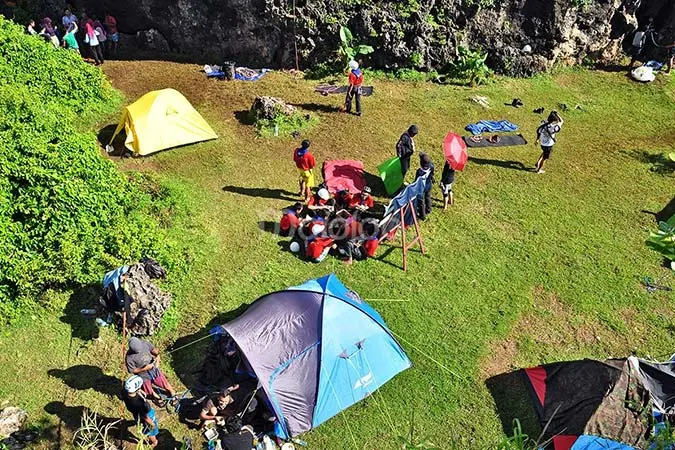Siung Beach is a coast surrounded by cliffs and has at least 250 international scale wall climbing trails on the coast of Gunungkidul Regency, Yogyakarta Province, Indonesia. The beach surrounded by high coral walls towers as a hidden paradise for rock climbers.
Siung Beach is located in a remote area approximately 77 kilometers from Yogyakarta. The stretch of white sand in the Indian Ocean line with the karst hills and teak trees is located in the Gunung Sewu Geopark area. The beach is reached through a winding road between the cliffs and palawija fields.
Giant corals on the west and east of the coast have an important role to play as breakers of the roar of ocean waves and gaps lined by flowing seawater slowly producing dramatic scenery. Although rich in various types of fish, not many people dare to go to sea and they are only looking for fish on the banks.
Fauna
Sewu Geopark is a native habitat for various turtles and as a location for laying eggs. Long-tailed macaques that are now increasingly scarce are still often found on Siung Beach. When the night or when visitors are quiet, a group of monkeys will descend from the top of the coral cliffs to the beach.
Rock climbing center
In 1989, the Japanese rock climbing team carried out an expedition on the cliffs on the west coast as a rock climbing arena and in the 90s an Asian Climbing Gathering was held which was attended by 250 athletes from 65 European and Asian countries to compete using the Siung Beach cliff as race site.
In 2005, the government established Siung Beach as a rock climbing center in Yogyakarta. Now at least 250 climbing routes have been mapped at Siung Beach to facilitate rock climbing sports fans.
Each path has a different level of difficulty and the lanes may still increase because a rule to be able to continue an existing route must obtain permission from the previous lane maker.
A wooden stage house was provided for the base camp and enough for 15 people, but a ground camp on the east coast was also available to set up tents and campfires to spend the night with rules not to damage the nature and disturb turtle habitat.
Siung Beach is located in a remote area approximately 77 kilometers from Yogyakarta. The stretch of white sand in the Indian Ocean line with the karst hills and teak trees is located in the Gunung Sewu Geopark area. The beach is reached through a winding road between the cliffs and palawija fields.
Giant corals on the west and east of the coast have an important role to play as breakers of the roar of ocean waves and gaps lined by flowing seawater slowly producing dramatic scenery. Although rich in various types of fish, not many people dare to go to sea and they are only looking for fish on the banks.
Fauna
Sewu Geopark is a native habitat for various turtles and as a location for laying eggs. Long-tailed macaques that are now increasingly scarce are still often found on Siung Beach. When the night or when visitors are quiet, a group of monkeys will descend from the top of the coral cliffs to the beach.
Rock climbing center
In 1989, the Japanese rock climbing team carried out an expedition on the cliffs on the west coast as a rock climbing arena and in the 90s an Asian Climbing Gathering was held which was attended by 250 athletes from 65 European and Asian countries to compete using the Siung Beach cliff as race site.
In 2005, the government established Siung Beach as a rock climbing center in Yogyakarta. Now at least 250 climbing routes have been mapped at Siung Beach to facilitate rock climbing sports fans.
Each path has a different level of difficulty and the lanes may still increase because a rule to be able to continue an existing route must obtain permission from the previous lane maker.
A wooden stage house was provided for the base camp and enough for 15 people, but a ground camp on the east coast was also available to set up tents and campfires to spend the night with rules not to damage the nature and disturb turtle habitat.

